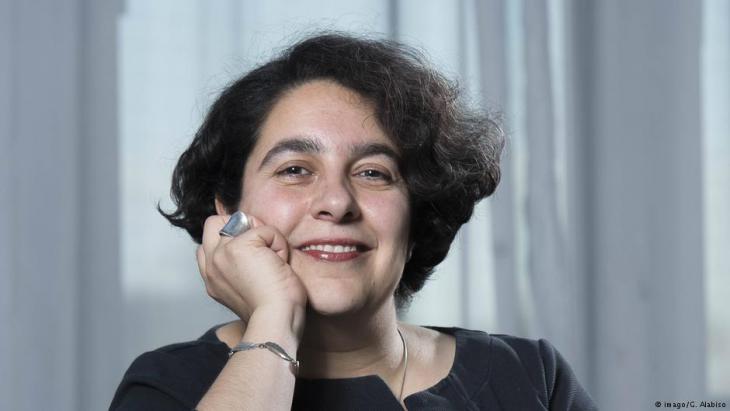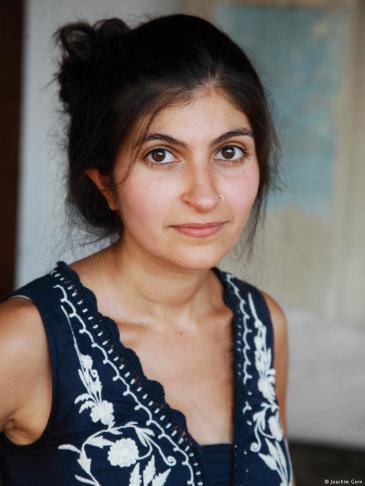Patchwork identities

Three novels by Persian-speaking writers recently published in Germany were written by women: the authors Mehrnousch Zaeri-Esfahani, Nava Ebrahimi and Shida Bazyar. They are part of the second generation of Iranian diaspora writers, their parents having fled the country following the 1979 Islamic Revolution to end up – more or less by chance – in Germany.
With the exception of Shida Bazyar, who was born in Hermeskeil in 1988, the young storytellers came to Germany as children of politically persecuted parents during the 1980s. Initially exposed to linguistic isolation, mental exile and cultural confusion, they took to writing as adults to set down the stories of their hybrid identities. Their books, with the titles ″33 Arches and a Teahouse″ (Zaeri-Esfahani), ″Sixteen Words″ (Ebrahimi) and ″Tehran Is Quiet by Night″ (Bazyar) unambiguously indicate the source of their creativity, also linked to Iran′s recent history.
The three writers confront the ordeal of flight and their unwelcome arrival in Germany in the language in which they once woke from their nightmares as children, in which they now dream of a colourful life: German.
Existential issues
The issues these young Scheherezades tackle have a long tradition in the genre of migration literature. They are not radically different from the material the first generation covered. Those literary pioneers also constructed their works on the heritage of collapsing utopias of a generation that resisted the Shah and mullah regimes with great willpower, went into exile despondent and had to build a new existence abroad.

Yet unlike most narratives of the ″old″ writers, their young successors draw a relatively positive picture of displacement as liberation. With the cool detachment of their generation, they take the edge off the academy′s antithetical ascriptions of home and abroad, place and placelessness, origin and identity, making a case for tolerance on both sides – following the rules of literary aesthetics.
Their stories thus focus on individuals weary of the burden of false evaluations and trying to liberate themselves from them, no matter whether their names are Mehrnoush like Zaeri-Esfahani′s protagonist or Mona, like the main character in Ebrahimi′s novel, or Nahid, Laleh and Morad, who tell the story in Bazyar′s book.
Their unique perspectives reveal new dimensions to the reader; they look upon the worlds of both cultures with an outsider′s gaze and vividly depict their own patchwork identities, sewn together using colourful associations of various shapes and forms.
At the same time, they criticise the ″disturbing″ elements of both systems when these, from a humane perspective, appear incompatible with free thought, while plumbing the scope for experiment between politics, marginalisation and artistic freedom in two cultural worlds.
In contrast to German critics′ readings, these works are not always concerned with the juxtaposition of modern and traditional life, but often with charting a place where these divergences meet and get along fine, in a manner that takes great skill to express.

Sources of creativity
Mehrnousch Zaeri-Esfahani′s autobiographical novel, for instance, tells the story of a girl born and bred on the River Zaiandeh Roud in her hometown of Isfahan.
After Ayatollah Khomeini comes to power, the young protagonist and her parents flee to Turkey, initially to the Bosporus in Istanbul and from there to various German rivers such as the Spree, Havel and Neckar, ending up in Heidelberg.
The small university town where she begins her new life gradually becomes a place where she goes in search of the familiar spaces of her childhood in Isfahan.
The novel ″Sixteen Words″ is another wide-open window onto the biography of its 38-year-old author Ebrahimi. Her parents too once fled from Iran′s Islamic Revolution.
Mona, the novel′s protagonist, was born in Tehran, but has lived in Cologne since early childhood and grown up bilingual. She knows her parents′ homeland from annual trips to visit relatives in Iran.
Having finished her degree and embarked on a long journalistic research trip to Tehran, she begins an affair with a married man, of which her German lover in Cologne is unaware: ″When I landed at Cologne-Bonn airport, everything was gone. As though a different Mona were disembarking from the plane,″ Ebrahimi explains her first-person narrator′s state of mind after her stay in Tehran.
The heroes of the novel ″Tehran Is Quiet by Night″ explain their attitudes and opinions on German and Iranian life themselves. They are the father Behsad, mother Nahid, daughter Lale and son Morad, who tell their stories over three decades, from 1979 to the defeat of the Green Movement in 2009. The novel is marked by the presence of its female characters and their charmingly bizarre worlds. Simultaneously, however, 27-year-old Bazyar builds a monument to the entire generation that resisted the atrocities of the mullah regime.
″Yes, my parents were part of the Communist resistance in Iran,″ she says of her book′s historical and political context. ″I got a lot of background information from them, but I created the characters from scratch.″ At the same time, she does identify with Morad, the family′s son, as a representative of his generation growing up in two or three cultures – Iranian, Kurdish and German. Bazyar emphasises: ″That hybrid identity is typical of my and Morad′s generation.″
Fahimeh Farsaie
© Iran Journal 2017
Translated from the German by Katy Derbyshire
Fahimeh Farsaie, lawyer, art and literature critic belongs to the first generation of female Iranian authors in Germany. In addition to screenplays, theatre pieces and radio plays, she has also published six novels: ″Nassrins ost-westliche Nacht″, ″Eines Dienstag beschloss meine Mutter Deutsche zu werden″, ″Hüte dich vor den Männern mein Sohn″, ″Die Flucht und andere Erzählungen″, ″Vergiftete Zeit″ and ″Die gläserne Heimat″. Several of her works have been translated into English and Spanish.
